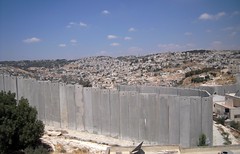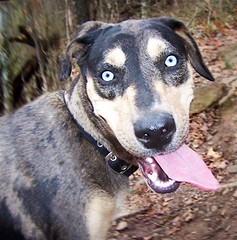
I returned from Palestine/Israel on the 24th. While there I had the opportunity to see Palestinian hip-hoppers G-town perform, and to spend part of a day in the Shu'afat refugee camp with bandleader Muhammad and a couple other members of the group (Giant M and Dr. E). (I hope in the future to write a post with more info about G-town.)
Muhammad told me that he doesn't think much of local (Palestinian) radio or television, but he really likes MTV Arabia, and especially the program, "Hiphopna" (Arabic for "our hip-hop"). Otherwise, satellite t.v. programs in Arabic don't cover Arab rap. (There are an amazing number of Arab satellite stations, many of which play lots and lots of music, but in all my time flipping channels, I never saw any videos or performances of Arab rap, or any non-mainstream music, for that matter.) So, it would appear that US corporation MTV is filling a significant gap in coverage of an important local(ized) popular musical form.
I had an interesting conversation about MTV Arabia (launched in November 2007) with Omar in Ramallah this Monday, the day I departed. He noted that the veejays on "Hiphopna" often wear kufiyas--but that the show doesn't play any Palestinian rap. Although during my six weeks in Israel/Palestine, I always stayed in places with lots of satellite stations, I had not seen MTV Arabia. I did some hunting yesterday, and found some video clips featuring one of the vj's--Palestinian-American Fredwreck (Farid Nassar)--wearing a cap with a kufiya pattern, as well as the photo above. (Fredwreck is wearing a red kufiya cap here, in a "Jeddah episode.")
Omar is doing research on the subject of the US use of hip-hop in cultural diplomacy. (I highly look forward to seeing the published results of this research.) His research suggests that those of interested in imperialism and cultural politics in the Middle East should be paying close attention to phenomena like MTV Arabia. Whereas it has become more or less conventional wisdom that US government-sponsored efforts like TV satellite channel al-Hurra and Radio Sawa have been failures (see Marc Lynch's latest post here), corporate efforts to accomplish roughly the same goal have been little criticized, as far as I can tell. (After talking to Omar, I am somewhat more skeptical about the positive uses of hip-hop for US cultural diplomacy than is Marc Lynch--see his latest thoughts here.)
So, here's a provisional estimate of what is going on with MTV Arabia. (Inshallah, someone will do or is doing some serious research on this, and will be able to make a more definitive analysis. Hell, I don't really even have much data!)
MTV Arabia's show fills a gaping hole: it broadcasts and disseminates Arab hip-hop, something no other Arab media, whether radio or satellite television, is doing. So it's a US corporation that gets credit for filling this critical cultural vacuum. And in turn this US corporation determines which Arab hip-hop artists are going to get wide play. (And which are not: to wit, politicized Palestinian rappers, like the very influential DAM, not to mention all the others. And I don't know which others.) Mind you, hip-hop style, particularly when it comes to clothing, is ubiquitous in the Middle East, and hip-hop is very popular among Arab youth. And hip-hop, of course, has "rebellious" and "authentic" resonances, given its history in the US. It is this aura of realness, oppositionality and hipness that hip-hop music and style can trade on as hip-hop circulates abroad. The corporate reality of hip-hop, as documented by astute observers like Jeff Chang, on the other hand, is not well known, and rather cleverly disguised. It therefore makes sense that MTV Arabia veejay Fredwreck might deploy hip-hop's "radical" credentials as well as evoke Palestine by flying his kufiya flag--at the same time as corporate interests are promoted and Palestinian hip-hop in particular gets erased or ignored.
I in no way mean to diss the hip-hop talents of Omar Boflot, the Egyptian rapper who was voted the top MC by Hiphopna's judging committee or Lebanon's MC Zoog, voted the "people's choice," at the end of the show's first season. (See ArabianBusiness.com's report here.) Both demonstrate skills, and I'm glad that the show has brought them to prominence. Omar Boflot honed his rapping abilities in Ghana. Check him out performing on the final episode of season one of Hiphopna here:
(But on the other hand, I'd still rather listen to the likes of DAM, or Clotaire K or Rayyes Bek from Lebanon, or MBS or Lotfi Double Kanon from Algeria, or any number of rappers from Morocco like Bigg or Muslim or Fnaire.)
I also don't want to diss the kufiya-wearing Fredwreck. He's Palestinian-American, and so unlike many hip-hoppers who have donned the kufiya, we can be sure that he understands what its symbolism is all about. Moreover, Fredwreck has not been afraid to articulate his opinions about Palestine--which he had visited three times as of fall 2006--when interviewed. For instance, here's what he had to say when interviewed by dubcnn in September 2006:
It’s like apartheid all over again you know what I’m saying but worse. They’re just stealing peoples' land out there and the people fight back they want to ask “oh they’re being terrorists” you know saying “they’re trying to attack us” but you know who attacked who first? You know who occupied whose country? Israel. And like this week you have the United Nations here and the United Nations have not one time…Just any country from the United Nations was to let happen to them what has happened in Palestine, I don’t know what those countries would do so it’s a really sad situation out there.
Moreover, Fredwreck, who is best known for his production work with Tha Dogg Pound, also launched a hip-hop effort to oppose the US invasion of Iraq, known as the STOP Movement. It resulted in, among other things, the release of two anti-war rap songs featuring the likes of KRS-One, Everlast, Mobb Deep and the Alchemist. (Download "Dear Mr. President" here and "Down with Us" here.)
There is even a surprising acknowledgement of Fredwreck's Palestine politics on the MTV Arabia website. The short description of Fredwreck says that "'he now counts his favourite city as Al Kods (occupied Jerusalem)..." "Occupied Jerusalem"!? Can we expect some right-wing attacks on MTV for its anti-Semitism?
But despite Fredwreck's personal politics, ultimately, I think, his kufiya baseball caps, and his Snoop Dogg affiliations, just provide MTV Arabia with a superficial patina of street cred and rebellion. (As do the green tips for living that are listed on the MTV Arabia website under "Social Campaign.") All in the interest of US (imperial) cultural diplomacy and corporate profit.
As I finish this, I have, as it happens, just read an article about an earlier era of cultural diplomacy in the Sunday New York Times. It concerns a photo exhibit that focuses on the State Department's deployment of "jazz ambassadors" in the era of the Cold War (check out the amazing slide show here--you don't see these photos in the print edition--except for the Armstrong which I've reproduced).
What struck me (and I'm guided in this thinking by my discussions with Omar) is that whereas the jazz musicians were willing to play abroad on behalf of the US government, they weren't simply puppets. Rather, they were quite politically aware. For instance:
"[Louis] Armstrong canceled a 1957 trip to Moscow after President Dwight D. Eisenhower refused to send federal troops to Little Rock, Ark., to enforce school-integration laws. 'The way they are treating my people in the South, the government can go to hell,' he said. 'It’s getting so bad, a colored man hasn’t got any country.'
Administration officials feared that this broadside, especially from someone so genial as 'Ambassador Satchmo,' would trigger a diplomatic disaster. Secretary of State John Foster Dulles told Attorney General Herbert Brownell that the situation in Arkansas was 'ruining our foreign policy.' Two weeks later, facing pressure from many quarters, Eisenhower sent the National Guard to Arkansas. Armstrong praised the move and agreed to go on a concert tour of South America."
The article goes on to discuss current US government efforts to deploy US musicians as cultural ambassadors, but unfortunately focuses mostly on jazz musicians and not on the hip-hop ones. Again--and I am informed here by my discussions with Omar--I'm skeptical that any US hip-hop ambassador, whether corporate sponsored or government sponsored, would show the political integrity and acumen of the likes of Satchmo.
ADDENDUM (July 2): I should have mentioned that the canonical study of the US "jazz ambassadors" is Penny M. Von Eschen's Satchmo Blows Up the World: Jazz Ambassadors Play the Cold War. I am told that a film based on this subject is in the works.

















